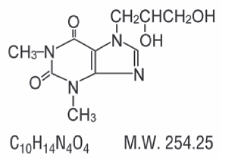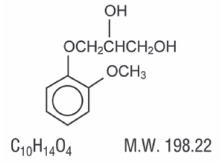DYPHYLLINE GG ES
-
dyphylline and
guaifenesin tablet
Breckenridge Pharmaceutical, Inc.
----------
Dyphylline GG ESDyphylline & Guaifenesin Tablets
Rx Only
DESCRIPTION
Each Dyphylline GG ES TABLET for oral administration contains:
| Dyphylline | 200 mg |
| Guaifenesin | 300 mg |
Dyphylline GG ES also contains the following inactive ingredients: Magnesium Stearate, Maltodextrin, Microcrystalline Cellulose, Polyvinylpyrrolidone, Silica, Sodium Saccharin, Sodium Starch Glycolate, Stearic Acid and Vanilla Flavor.
Dyphylline is a bronchodilator which occurs as a white, odorless, extremely bitter, amorphous or crystalline solid. It is freely soluble in water; sparingly soluble in alcohol and in chloroform; practically insoluble in ether. The chemical name is 1H Purine-2,6-dione, 7-(2,3- dihydroxypropyl)-3,7-dihydro- 1,3-dimethyl-. Its structural formula is as follows:

Guaifenesin is an expectorant which occurs as a white to slightly gray, crystalline powder, having a bitter taste. It may have a slight characteristic odor. It is soluble in water, alcohol, chloroform, glycerin, and propylene glycol. The chemical name is 1, 2-Propanediol, 3-(2-methoxyphenoxy)-. Its structural formula is as follows:

CLINICAL PHARMACOLOGY
Dyphylline is a xanthine derivative with pharmacologic actions similar to those of theophylline and other members of this class of drugs. Its primary action is that of bronchodilation, but it also exhibits peripheral vasodilatory and other smooth muscle relaxant activity to a lesser degree. The bronchodilatory action of dyphylline, as with other xanthines, is thought to be mediated through competitive inhibition of phosphodiesterase with a resulting increase in cyclic AMP producing relaxation of bronchial smooth muscle.
Dyphylline is well tolerated and produces less nausea than aminophylline and other alkaline theophylline compounds when administered orally. Unlike the hydrolyzable salts of theophylline, dyphylline is not converted to free theophylline in vivo. It is absorbed rapidly in therapeutically active form and in healthy volunteers reaches a mean peak plasma concentration of 17.1 mcg/mL in approximately 45 minutes following a single oral dose of 1000 mg of dyphylline.
Dyphylline exerts its bronchodilatory effects directly and, unlike theophylline, is excreted unchanged by the kidneys without being metabolized by the liver. Because of this, dyphylline pharmacokinetics and plasma levels are not influenced by various factors that affect liver function and hepatic enzyme activity, such as smoking, age, or concomitant use of drugs which affect liver function.
The elimination half-life of dyphylline is approximately two hours (1.8-2.1 hr) and approximately 88% of a single oral dose can be recovered from the urine unchanged. The renal clearance would be correspondingly reduced in patients with impaired renal function. In anuric patients, the half-life may be increased 3 to 4 times normal.
Dyphylline plasma levels are dose-related and generally predictable. The therapeutic range of plasma levels within which dyphylline can be expected to produce effective bronchodilation has not been determined.
Guaifenesin is an exportant which increases respiratory tract fluid secretions and helps to loosen phlegm and bronchial secretions. By reducing the viscosity of secretions, guaifenesin increases the efficiency of the cough reflex and of ciliary action in removing accumulated secretions from the trachea and bronchi. Guaifenesin is readily absorbed from the gastrointestinal tract and is rapidly metabolized and excreted in the urine. Guaifenesin has a plasma half-life of one hour. The major urinary metabolite is β-(2-methoxyphenoxy) lactic acid.
INDICATIONS AND USAGE
Dyphylline GG ES is indicated for the temporary relief of shortness of breath, tightness of chest, and wheezing due to bronchial asthma. Dyphylline GG ES also helps to loosen phlegm (mucus) and thin bronchial secretions to make coughs more productive.
CONTRAINDICATIONS
Hypersensitivity to any of the ingredients or related compounds.
WARNINGS
A persistent cough may be a sign of a serious condition. If cough persists for more than 1 week, tends to recur, or is accompanied by a fever, rash, or persistent headache, consult a physician.
Do not take this product for persistent or chronic cough such as occurs with smoking, asthma, chronic bronchitis, or emphysema, or where cough is accompanied by excessive phlegm (mucus) unless directed by your physician.
Do not use this product unless a diagnosis of asthma has been made by a doctor.
Do not use this product if you have heart disease, high blood pressure, thyroid disease, diabetes, or difficulty in urination due to enlargement of the prostate gland unless directed by a doctor.
Do not use this product if you have ever been hospitalized for asthma or if you are taking any prescription drug for asthma unless directed by a doctor. Dyphylline GG ES is not indicated in the management of status asthmaticus, which is a serious medical emergency.
Although the relationship between plasma levels of dyphylline and appearance of toxicity is unknown, excessive doses may be expected to be associated with an increased risk of adverse effects.
PRECAUTIONS
General
Use Dyphylline GG ES with caution in patients with severe cardiac disease, hypertension, hyperthyroidism, acute myocardial injury or peptic ulcer. Before prescribing medication to suppress or modify cough, it is important to ascertain that the underlying cause of cough is identified, that modification of cough does not increase the risk of clinical or physiological complications, and that appropriate therapy for the primary disease is instituted.
Drug/Laboratory Test Interactions
Do not use this product if you are now taking a prescription monoamine oxidase inhibitor (MAOI) (certain drugs for depression, psychiatric, or emotional conditions, or Parkinson's disease), or for 2 weeks after stopping the MAOI drug. If you do not know if your prescription drug contains an MAOI, ask a doctor or pharmacist before taking this product. Synergism between xanthine bronchodilators (e.g., theophylline), ephedrine, and other sympathomimetic bronchodilators has been reported. This should be considered whenever these agents are prescribed concomitantly.
Concurrent administration of dyphylline and probenecid, which competes for tubular secretion, has been shown to increase the plasma half-life of dyphylline. Guaifenesin may increase renal clearance for urate and thereby lower serum uric acid levels.
Guaifenesin may produce an increase in urinary 5- hydroxyindoleacetic acid and may therefore interfere with the interpretation of this test for the diagnosis of carcinoid syndrome. It may also falsely elevate the VMA test for catechols. Administration of this drug should be discontinued 48 hours prior to the collection of urine specimens for such tests.
Carcinogenesis, Mutagenesis, and Impairment of Fertility
No long-term animal studies have been performed with Dyphylline GG ES.
Usage In Pregnancy
Pregnancy Category C
Animal reproduction studies have not been conducted with Dyphylline GG ES. It is also not known whether it can cause fetal harm when administered to a pregnant woman or can affect reproduction capacity. Dyphylline GG ES should be given to a pregnant woman only if the potential benefit to the mother, justifies the potential risk to the fetus.
If pregnant, or planning to become pregnant or are currently breast-feeding please contact your physician, or health-care provider before using or continuing use.
Nursing Mothers
Dyphylline is present in human milk at approximately twice the maternal plasma concentration. This product should not be given to nursing mothers.
Pediatric Use
Safety and effectiveness in the pediatric population has not been established. This product is not indicated for use in the pediatric population.
ADVERSE REACTIONS
Dyphylline GG ES may cause nausea, headache, cardiac palpitation and CNS stimulation. Postprandial administration may help avoid gastric discomfort.
The following adverse reactions have been reported with other xanthine bronchodilators and have most often related to excessive drug plasma levels. They should be considered as potential adverse effects when dyphylline is administered:
Gastrointestinal: nausea, vomiting, epigastric pain, hematemesis, diarrhea
Central Nervous System: headache, irritability, restlessness, insomnia, hyperexcitability, agitation, muscle twitching, generalized clonic and tonic convulsions.
Cardiovascular: palpitation, tachycardia, extrasystoles, flushing, hypotension, circulatory failure, ventricular arrhythmias.
Respiratory: tachypnea
Renal: albuminuria, gross and microscopic hematuria, diuresis.
Other: hyperglycemia, inappropriate ADH syndrome.
OVERDOSAGE
There have been no reports, in the literature, of overdosage with Dyphylline GG ES. However, the following information based on reports of theophylline overdosage are considered typical of the xanthine class of drugs and should be kept in mind.
Signs and symptoms
Restlessness, anorexia, nausea, vomiting, diarrhea, insomnia, irritability, and headache. Marked overdosage with resulting severe toxicity has produced agitation, severe vomiting, dehydration, excessive thirst, tinnitus, cardiac arrhythmias, hyperthermia, diaphoresis, and generalized clonic and tonic convulsions. Cardiovascular collapse has also occurred, with some fatalities. Seizures have occurred in some cases associated with very high theophylline plasma concentrations, without any premonitory symptoms of toxicity.
Treatment
There is no specific antidote for overdosage with drugs of the xanthine class. Symptomatic treatment and general supportive measures should be instituted with careful monitoring and maintanence of vital signs, fluids, and electrolytes. The stomach should be emptied by inducing emesis if the patient is conscious and responsive, or by gastric lavage, taking care to protect against aspiration especially in comatose or stuporous patients. Maintenance of an adequate airway is essential in case oxygen or assisted respiration is needed. Sympathomimetic agents should be avoided but sedatives such as short-acting barbiturates may be useful. Dyphylline is dialyzable and, although not recommended as a routine procedure in overdosage cases, hemodialysis may be of some benefit when severe intoxication is present or when the patient has not responded to general supportive and symptomatic treatment.
DOSAGE AND ADMINISTRATION:
DO NOT EXCEED RECOMMENDED DOSAGE.
Dyphylline GG ES: Adults and adolescents 18 years of age and over: 1 tablet administered orally 3 or 4 times daily. In severe cases, dosage may be doubled if necessary. Maintenance dosage should be adjusted according to patient response.
HOW SUPPLIED
Dyphylline GG ES, each tablet of which contains dyphylline 200 mg and guaifenesin 300 mg, are supplied as a white, capsule shaped tablet, embossed "B 536" in bottles of 100, NDC 51991-536-01.
STORAGE
Store at 25°C (77°F); excursions permitted to 15°- 30°C (59°-86°F). See USP Controlled Room Temperature.
Dispense in a tight, light-resistant container with a child-resistant closure as defined in the USP/NF.
WARNING: Keep this and all medications out of the reach of children. In case of accidental overdose seek professional assistance or contact a poison control center immediately.
All prescription substitutions using this product shall be pursuant to state statutes as applicable. This is not an Orange Book product.
Rx Only
Manufactured By:
Contract Pharmacal Corp.
Hauppauge, NY 11788
Distributed By:
Breckenridge Pharmaceutical, Inc.
Boca Raton, FL 33487
Rev. 06/09
PRINCIPAL DISPLAY PANEL - 100 Tablet Bottle Label
Breckenridge
Pharmaceutical, Inc.
NDC 51991-536-01
Dyphylline GG ES
Dyphylline & Guaifenesin
Tablets
Rx Only
100 TABLETS

| DYPHYLLINE GG ES
dyphylline and guaifenesin tablet |
||||||||||||||||||||
|
||||||||||||||||||||
|
||||||||||||||||||||
|
||||||||||||||||||||
|
||||||||||||||||||||
|
||||||||||||||||||||
| Marketing Information | |||
| Marketing Category | Application Number or Monograph Citation | Marketing Start Date | Marketing End Date |
| UNAPPROVED DRUG OTHER | 02/01/2008 | 02/28/2012 | |
| Labeler - Breckenridge Pharmaceutical, Inc. (150554335) |
| Establishment | |||
| Name | Address | ID/FEI | Operations |
| Contract Pharmacal | 057795122 | MANUFACTURE | |